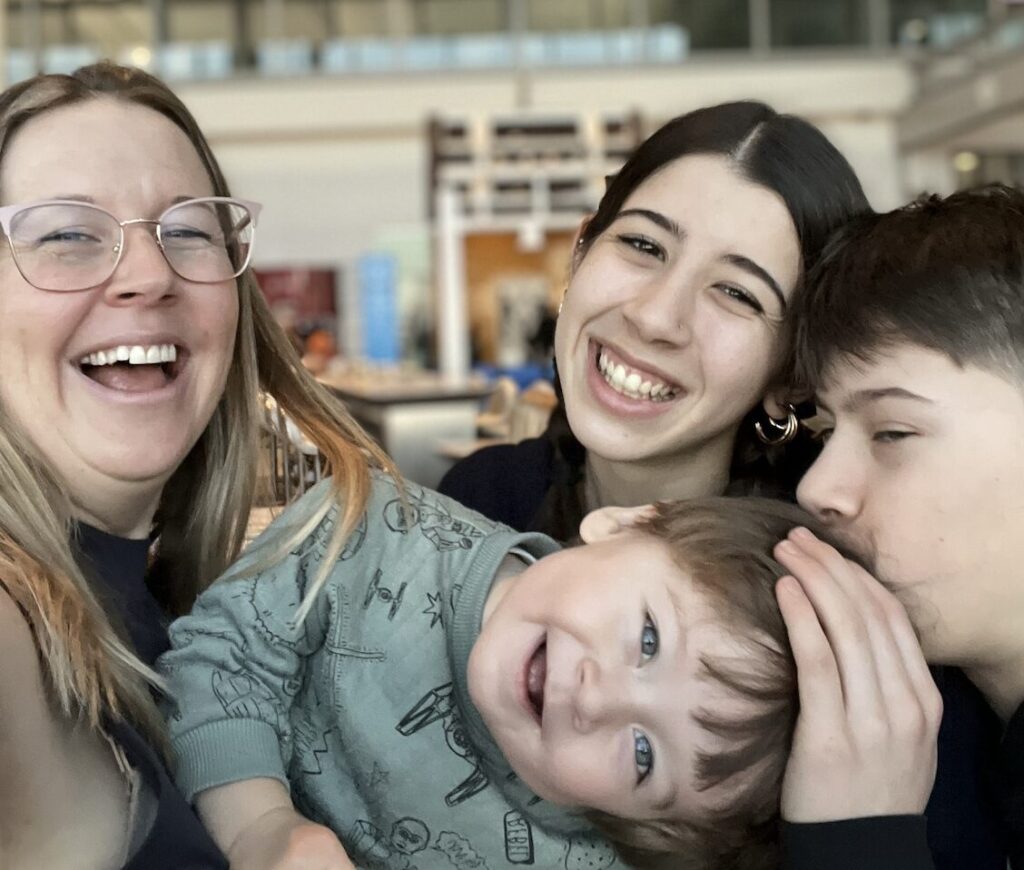Are kids harmed by entertainment aimed at older audiences?
Lori Pearson and her husband were standing in line behind a mother and son at the video store one day, when they overheard the following exchange. The mother, unsure about the movie they were about to rent, asked the clerk what the rating PG-13 meant and would this particular movie be OK for her 10-year-old to watch? The clerk could not answer and the mother and son left. “I told my husband, there has to be some better rating system, one that doesn’t rely on age as an arbitrary cut-off.”
And so the Ohio couple launched Kids-In-Mind.com. The website gives parents a more robust look at what they can expect to see in a given movie, rating it on a scale of zero to 10 in three categories: sex and nudity, profanity, and violence and gore. Each rating includes a description of exactly what parents and children can expect to see, such as “a man without a shirt kisses a woman,” or “woman gets drunk.”
“Our thinking is that knowledge is power,” says Lori. “Some families are more sensitive to violence, others to sex and nudity. A generic rating of PG-13 (Parental Guidance for 13 and under, in the U.S.) doesn’t give you much to go on.”
Today’s rating system is the product of about a century of movie-going. Initially, ratings were established as a measure to keep sexual content off the screens. In the 1920s, the Hayes Code was created and films relied on the Hayes seal to get distributed. That meant sinners and wrongdoers could not be portrayed in a sympathetic light (sorry Pretty Woman), as well as no nudity, suggestive dancing, illegal drug use, homosexuality, offensive language or interracial marriage, as well as other so-called bad things.
But after 30 years, the artistic will of filmmakers and the growing sophistication of movie-goers put an end to the Hayes Office. In 1968, the Motion Picture Association of America (MPAA) introduced the first classification of movies: G (general audience); M (mature audience); R (16+ unless accompanied by a parents or guardian); X (under 16 not admitted). By 1970, a GP rating was added, the precursor to PG, or the parental guidance label.
Fast Forward
It wasn’t until 1984 that the PG-13 rating appeared, because parents were upset about the level of violence and gore in the PG-rated hit movies Indiana Jones and the Temple of Doom and Gremlins. Then in 1990, the X-rating was replaced with NC-17, because the X-rating had become synonymous with pornography.
The rating system differs slightly in Canada (though exposure to U.S. movie ads can create some confusion). In most provinces, the PG rating is followed by 14A or 14, (except in Quebec, where there is a G rating, 13+ and 16+ ratings). Most provinces also have an 18A rating (those under 18 must be accompanied by an adult) and an R rating (only people 18 and over admitted).
Complicating matters is that movie classifications are determined provincially. So, your kids’ cousins living in another part of the country might be “allowed” to see a movie in a theatre unaccompanied in their city, while your kids may not be able to do so where you live. Also, movies are classified first for theatrical release, then for home video release. To see how your province or territory does it, visit media-awareness.ca. Canadian television ratings, created in 1997, reflect our film ratings, with the addition of C for children 2 to 7 and C8 for children 8 and older. (French-language broadcasters follow Quebec’s age-based film rating system). American television ratings are slightly different.
Stop
Despite all the diligent rating guides, it still hasn’t stopped mature content from finding its way into PG-13 or 14A movies.
Lori knows this firsthand. “We’ve participated in a study about content creep, and since the MPAA first started implementing ratings, there has been a marked increase in the amount of mature content in films. The PG-13 is the new R. There are just so many instances when I shake my head.”
She’s not alone. Cleo Hamel is the mother of two daughters, Michela, 14, and Alexa, 13, in Calgary. “This is an ongoing conversation for me and my husband,” says Cleo. When it comes to TV shows and movies, the couple uses the 14A rating as a guide but tries to prescreen as much as they can in order to determine if their daughters are ready for what’s on screen.
“It might say, some violence or sexual content, but you never know to what degree. The other day, we rented The Girl with the Dragon Tattoo and ended up not letting the girls watch it. On the other hand, sometimes, we’ll find it wasn’t that bad. They’ve seen worse on the Internet,” says Cleo.
And that is important to remember. “Sometimes we worry too much,” says Dr. Ester Cole, a psychologist in private practice in Toronto. “Parents have to remember that children want to belong. If your child is the only one among their friends not allowed to see a film, they will likely still be exposed to the information because their friends will be talking about it. If they are prepared to have you see it with them, then go, and have the discussion. Why was there so much swearing? Drinking? Was there a better way of handling it? Could it have been funny without the bad language? This will give them your perspective and you can reinforce your family’s values.”
Pause
Watching movies together can stimulate conversation topics. “It allows
us to talk about the way some girls are portrayed and about situations
or issues they might not be prepared for,” says Cleo. “As they get
older, it gets harder. At this point, we still have the ability to make
decisions and we value that. Soon we won’t be able to. I give my
daughters credit. I can be honest with them and say I don’t think it’s
appropriate and this is why. When it comes out on DVD we’ll consider
it.”
Kelly Matzen, a Vancouver-based family counsellor and founder of
parentingtouchstones.com, has strong feelings about the role parents
should be playing in overseeing their preteens’ viewing habits. “It
boils down to monkey see, monkey do. Children are brilliant observers
but they are lousy interpreters. Context and situational awareness will
go right over their heads. So this means they are passively taking in a
show – not to mention the commercials and product placements – and are
very likely coming to incorrect, often unethical and materialistic
conclusions,” says Kelly. “For instance young girls viewing promiscuous,
scantily clad young women in shows like Desperate Housewives – popular
among eight- to 12-year-olds – may come to the conclusion this is the
way to act and dress in order to get attention. Movie and TV ratings are
at best vague guidelines. They don’t do our job for us as parents. Even
cartoons can send wrong messages about violence and self-esteem.”
Michelle
Magee of Richmond Hill, Ont., had her own rude awakening to the mature
content of some cartoons last year. Her 10-year-old son, Finn, started
watching cartoons his friends had been watching. “I thought, they’re
cartoons, they should be all right,” says Michelle. In this case it was
Futurama (rated PG) and Robot Chicken (with the U.S. television rating
of MA for mature audience, which is older than 21).
“When my husband
and I got around to viewing them we quickly realized they were
completely inappropriate. There was lots of violence, lots of blood, and
in one case, the cartoon characters were having sex. It made us much
more vigilant,” says Michelle. She and her husband asked Finn about what
he was watching and explained their own concerns. “He agreed it wasn’t
appropriate,” says Michelle. “I want my kids to fully understand what
they are seeing and I’m not in a rush for them to grow up.”
Neither
is Kendra Lachine of Ottawa. Her stepson Edward is 11 and still enjoys
watching family or G-rated movies. However, he does see trailers for
more adult movies and he is drawn to them and would like to go to them,
she says.
“When we are looking for a movie to go to, we choose those
rated PG, which I assume is appropriate, and typically it has been. We
might choose 14A if we are familiar with the movie. Otherwise, I
research it. I have a bigger problem with violence than I do with sexual
content or political content. I think as a general practice, if mature
content can be contextualized we will have a discussion afterwards so he
is able to ask questions and understand what he is watching.”
Play
Cleo,
Michelle and Kendra all feel it is important to know your child and
what they are ready for when deciding what to let them watch. “You can’t
just assume all 14A movies are bad for tweens,” says Kendra. “It
depends on the family and the child.” Lori Pearson agrees. “Some
children are more prepared to handle and understand more mature content
than others. Some children are very sensitive to violence. Others are
not. My best advice for parents is to invest the time to learn as much
about the movie or TV program beyond that initial PG-13 or 14A rating as
possible and then decide if it’s something your child is ready for.”
14A – Yes or No?
Tips and strategies on deciding what’s appropriate
Check the reviews.
Michelle
Magee takes a closer look when she sees a PG-13 or 14A rating. “I
always go to three websites to get more specifics on what I can expect
to see:
The movies are often rated by parents and educators and I have a clearer picture of what’s in the movie.”
Watch it yourself.
“Preview shows as much as possible,” says Kelly Matzen. Talk to parents who have viewed shows you haven’t seen. View trailers.
Talk about it.
Talk
to your children about what they are seeing so you can figure out what
conclusions they are coming to, says Kelly. The more they understand
they are being sold a certain image, the better off they will be when it
comes to critical thinking. That is essential if they are to make
smart, good decisions in the future.
Know your child.
“Some
11-year-olds may be mature enough to watch a 14A movie while some
14-year-olds are not,” says Dr. Cole. “If your child has seen an
inappropriate movie, don’t be too worried – unless it becomes a pattern.
If excessively violent movies are the only preferred form of
entertainment, then it is a concern.”
Published in June, 2011.
Mary Teresa Bitti is a freelance journalist based in Toronto and mother of two children.











